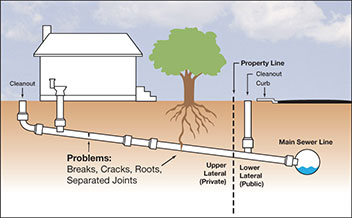Do I Auger My Home Sewer Line, or Call for Help?

In order to auger the sewage line yourself, you must be tremendously brave, brave enough to get dirty…not just from dirt. To clarify the procedure, a home sewer line is the big drain pipe (usually 4-inch) that runs from the bottom of main waste/vent stack (main drain) in the house, down under the yard, and into the city sewer main, under the street. The city only tends to the main sewer line. The remaining lines are the homeowner’s responsibility. Emergency plumbing Los Angeles contained everyday by DIY homeowners and professionals. Soliciting assistance will be necessary whether you call the pros or an obliging friend.
The royal flush- to auger the drain you must access the cleanout, which is an access hole in the sewer line, built especially for cleaning. The cleanout could be a threaded plug at the end of a fitting or a short length of pipe that attaches to the main drain. Usually it is found in the basement or crawlspace- search for the main drain outdoors (under a plug or small manhole sealing). If you have an older house, it may not have a cleanout. In which case, a plumber should be called, because the toilet will have to be removed and an extensive amount of work will be done through that pipe connection.
Sewer augers or snakes are available for rent at tool rental outlets. Made of 50-100 feet of cable wrapped inside a metal spool, this power tool is turned by a reversible electric motor. The auger frame has two wheels, so it can be tipped back and moved around as you would move a dolly. The aggressive end of the cable has a curved, two-pronged cutter head that rotates along with the cable to penetrate the clog. Augers are heavy; the rental staff will need to help you load it into your truck or SUV. Car trunks are too small for transport. The cost will be about $65 an hour.
The process begins with the removal of the cleanout plug or cover. If you are a thrill seeker, this is where the supreme excitement lies. You need to wait until the drain is empty above the cleanout before removing it. When the clog is terrible and nothing drains, either call a pro, or find a safe and relatively clean way to capture contents that will explode from the pipe.
If you know the clog is beneath the cleanout, proceed by positioning the auger a few feet from the cleanout. Plug its power cord into a nearby electrical outlet. Usually augers will have a foot pedal for hands-free operation, so be sure to place it somewhere that is convenient. Pull the cable out and feed it a few feet into the pipe.
When the cutter hits a bend or clog, do not force it. Instead slightly retract the cable then feed it again gently. If you let the cutter spin and rotate too much, it will coil and break. The pressure should build a little before you yank the cable back setting the cutter free. Feed the cable again, and continue to repeat the process. Your persistent action should break the clog. A satisfying whoosh sound may be your triumphant success signal. Sometimes the clean out is not as dramatic, but it is just as significant. When the clog is clear, run water through the drain, and wash off the auger. Leave the water hose on for a few minutes to ensure a clean drain.
(Citation: Networks, “How to Auger Your Home Sewer Line” Schmidt, Philip)

